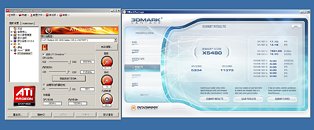Monday, March 23rd 2009

RV790 Reaches 1.00 GHz, Indicates Overclocked SKUs in the Making
Following our report of ASUS preparing an overclocked Radeon HD 4890 accelerator with clock speeds well above 900 MHz (core) and 1000 MHz (memory), the possibility has come to surface that AMD has carved out a new range of Radeon HD 4890 accelerators from the unusually high overclocking headroom the RV790 GPU has. The credit also goes to the reference-design PCB, which is known to possess some of the highest quality digital PWM components to handle power, and 4 GT/s GDDR5 memory, which is now known to have a good overclocking headroom.
It has surfaced on the forums of Chinese tech community PCInLife, that the RV790 rather effortlessly reached the 1 GHz mark, the slider-limit of Catalyst Control Center, sparking off fresh rumors that AMD partners may be creating a fresh niche of highly-overclocked cards shortly after Radeon HD 4890 comes to be. The overclocker reached speeds of 1 GHz (core) and 1125 MHz (4.50 GHz effective, memory). At the said speeds, the card was put through 3DMark Vantage with its eXtreme settings. It churned-out a score of X5480, which puts its performance somewhere between those of the GeForce GTX 280 and GeForce GTX 285. It should also be taken into account that the drivers RV790 users the world over have been using, are preliminary beta drivers. AMD plans to release Catalyst 9.4 with the release of Radeon HD 4890, which just may impact positively on the performance of the product.Factory-overclocked cards based on ATI Radeon have since now been a formality. Even cards with the iconic HIS IceQ TurboX branding, haven't been known to have high (~15~20%) increase in clock speeds. With this feat surfacing, it has been established that the RV790 holds the capability to reach some very high clock speeds. On course to the 1 GHz mark, the overclocker at PCInLife comfortably reached 925/1025 MHz (X5021) and 950/1075 MHz (X5202). It sounds plausible that these speeds could be the speeds factory-overclocked cards come at, with a branding system similar to what NVIDIA uses: a tier-1 (light overclock), tier-2 (moderate overclock), tier-3 (high overclock), and tier-4 (extreme overclock). At any rate, this is turning out to be an exciting fortnight for the high-end GPU industry.
Source:
PCInLife
It has surfaced on the forums of Chinese tech community PCInLife, that the RV790 rather effortlessly reached the 1 GHz mark, the slider-limit of Catalyst Control Center, sparking off fresh rumors that AMD partners may be creating a fresh niche of highly-overclocked cards shortly after Radeon HD 4890 comes to be. The overclocker reached speeds of 1 GHz (core) and 1125 MHz (4.50 GHz effective, memory). At the said speeds, the card was put through 3DMark Vantage with its eXtreme settings. It churned-out a score of X5480, which puts its performance somewhere between those of the GeForce GTX 280 and GeForce GTX 285. It should also be taken into account that the drivers RV790 users the world over have been using, are preliminary beta drivers. AMD plans to release Catalyst 9.4 with the release of Radeon HD 4890, which just may impact positively on the performance of the product.Factory-overclocked cards based on ATI Radeon have since now been a formality. Even cards with the iconic HIS IceQ TurboX branding, haven't been known to have high (~15~20%) increase in clock speeds. With this feat surfacing, it has been established that the RV790 holds the capability to reach some very high clock speeds. On course to the 1 GHz mark, the overclocker at PCInLife comfortably reached 925/1025 MHz (X5021) and 950/1075 MHz (X5202). It sounds plausible that these speeds could be the speeds factory-overclocked cards come at, with a branding system similar to what NVIDIA uses: a tier-1 (light overclock), tier-2 (moderate overclock), tier-3 (high overclock), and tier-4 (extreme overclock). At any rate, this is turning out to be an exciting fortnight for the high-end GPU industry.

103 Comments on RV790 Reaches 1.00 GHz, Indicates Overclocked SKUs in the Making
But on that other part, Id run a fan at max to see what a card can do because if the card can't go that far with the fan at max even, either the cooler is not that good, or the Core is already reached its max, but from looks of it the 4890 is a good part indeed. TBH I wish I could run my fan at max but CCC wont allow it on the 1950, I know the fan is capable of it because it does run at max during POST (Runs at Max Speed) before it's handed off to the Operating system. Also lets be honest here, CPUs/GPUs that run at very high speeds on Stock/lower voltage and Stock Cooler are the Cherry Picked Parts- thus they slap higher price tag on it, all the rest else cant without voltage adjustment or requires 3rd party cooling. I also believe companies dont max the Cores of their Parts out because they want to make you think you are actually getting an extreme overclock out of it. I remember during the Socket7-P3/Athlon Era that a 100MHz OC was a Major Feat, and all CPUs at time were very high in pricing- aka before they ever thought of the Extreme Parts
Anyways end rant and thx for the Kudos
The HD4890 is nothing more than an RV770 with a beefed up power scheme to allow higher clocks. From what I have seen, there is nothing special about the RV790 over the RV770, they are the exact same core, any improvements come from the PCB not the GPU core, maybe some binning was done to pick the top RV770's to put on the HD4890's but that is it. AMD just changed the name to raise the hype level.
doesnt seem to do much more than allow for the higher clock speeds for now, the meat of the GPU appears exactly the same.
All we are going on is AMD naming it RV790, that is really the only thing that tells use it is a new chip. I'm just saying, I don't think it is any different from RV770. I believe RV790 is nothing more than a binned RV770, and the PCB has been beefed up to allow higher more stable voltage, leading to higher clocks. There have been no changes to the core itself.
now stop :cry: and be a man! :laugh:
I understand there's differences in architecture, but doesn't a chip using a higher frequency need more voltage? And less voltage for more performance is where we want to go, not more voltage for equal amount of performance...
Still though, as always, amd will need to offer these cards at a killer price to compete with nvidia. Also, they aren't using havok in their drivers just yet. These preliminary tests show promise.
is not a new design is based on 770 but they've made a few important modification;i think the power leakage is less than at 770 also this is why it can reach 1ghz so easy
time will tell soon what is under the cover..
its from the main story:o